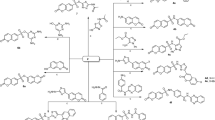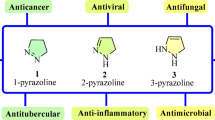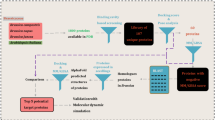Abstract
Chloromonilicin was isolated for the first time from Alternaria sonchi, a mycoherbicide proposed for the control of the noxious weed Sonchus arvensis. The already known alternethanoxins A and B and the three recently isolated phytotoxic polycyclic ethanones named alternethanoxins C–E were also isolated from the same source. Chloromonilicin was identified by spectroscopic data (essentially one-dimensional NMR, 2-dimensional NMR and high-resolution ESI-MS) and its structure was confirmed by single X-ray analysis, which also allowed the assignment of the absolute configuration. This latter was independently confirmed by electronic CD calculations. When chloromonilicin was tested for its antimicrobial activity, it was active at concentrations 0.5–1 μg per disc against four bacterial species and a yeast fungus. The compound inhibited conidial germination of four plant pathogens at concentration of 1–10 μg ml−1. No phytotoxic activity of this antibiotic by leaf-disc puncture bioassay was detected.
Similar content being viewed by others
Log in or create a free account to read this content
Gain free access to this article, as well as selected content from this journal and more on nature.com
or
References
Donald, W. W. Management and control of Canada thistle (Cirsium arvense. Rev. Weed Sci. 5, 193–250 (1990).
Evans, H. C. in Biological Control of Weeds with Fungi. The Mycota Vol. 11, 145–172 Springer-Verlag, Berlin Heidelberg, (2013).
Cimmino, A. et al Abstracts of Papers 8th PSE (The Phytochemical Society of Europe) Meeting on Biopesticides, La Palma, Canary Islands, Spain, (2009).
Vurro, M. in Novel Biotechnologies for Biocontrol Agent Enhancement and Management (eds Vurro, M. & Gressel, J.), Ch. 3, 53–74 (Springer, Netherlands, 2007).
Cimmino, A., Andolfi, A., Berestetskiy, A. & Evidente, А Production of phytotoxins by Phoma exigua var. exigua, a potential mycoherbicide against perennial thistles. J. Agric. Food Chem. 56, 6304–6309 (2008).
Berestetskiy, A. O. & Kurlenya, A. S. Antimicrobial properties of some phytopathogenic micromycetes. Mikologia Fitopatologia 48, 123–134 (2014).
Evidente, A., Punzo, B., Andolfi, A., Berestetskiy, A. & Motta, A. Alternethanoxin A and B, polyciclic ethanones produced by Alternaria sonchi, potential mycoherbicides for Sonchus arvenis biocontrol. J. Agric. Food Chem. 57, 6656–6660 (2009).
Berestetskiy, A. et al. Alternethanoxins C-E, further polycyclic ethanones produced by Alternaria sonchi, a potential mycoherbicide for Sonchus arvensis biocontrol. J. Agric. Food Chem. 63, 1196–1199 (2015).
Bury, M. et al. Evaluation of the anticancer activities of two fungal polycyclic ethanones, alternethanoxins A and B, and two of their derivatives. Int. J. Oncol. 38, 227–232 (2011).
Berger, S. & Braun, S. 200 and More Basic NMR Experiments: A Practical Course (Wiley-VCH, Weinheim, 2004).
Altomare, A. et al. A new tool for crystal structure determination and refinement. J. Appl. Crystallography. 32, 115–119 (1999).
Sheldrick, G. M. A short history of SHELX. Acta Crystallogr. A64, 112–122 (2008).
Flack, H. D. On enantiomorph-polarity estimation. Acta Crystallogr. A39, 876–881 (1983).
Frisch, M. J. et al Gaussian’09, Revision D.01, (Gaussian, Inc., Wallingford, CT, (2013).
All references about DFT functionals, basis sets and solvent models can be found in the on-line documentation for Gaussian’09 at www.gaussian.com/g_tech/g_ur/g09help.htm.
Bottalico, A., Capasso, R., Evidente, A., Randazzo, G. & Vurro, M. Cytochalasins: structure-activity relationships. Phytochemistry 29, 93–96 (1990).
Onishi, H. R. et al. Antibacterial agents that inhibit lipid A biosynthesis. Science 274, 980–982 (1996).
Talontsi, F. M. et al. Zoosporicidal metabolites from an endophytic fungus Cryptosporiopsis sp. of Zanthoxylum leprieurii. Phytochemistry 83, 87–94 (2012).
Berestetskii, A. O. et al. Isolation, identification, and characteristics of the phytotoxin produced by the fungus Alternaria cirsinoxia. App. Biochem. Microbiol. 46, 75–79 (2010).
Rao, J. V., Srikanth, K., Arepalli, S. K. & Gunda, V. G. Toxic effects of acephate on Paramecium caudatum with special emphasis on morphology, behaviour, and generation time. Pestic. Biochem. Phys 86, 131–137 (2006).
Sassa, T., Kachi, H. & Nukina, M. Chloromonilicin, a new antifungal metabolite produced by Monilinia fructicola. J. Antibiot. (Tokyo) 38, 439–441 (1985).
Kachi, H., Hattori, H. & Sassa, T. A new antifungal substance, bromomonilicin, and its precursor produced by Monilinia fructicola. J. Antibiot. (Tokyo) 39, 164–166 (1986).
Kachi, H. & Sassa, T. Isolation of monilphenone, a key intermediate in xanthone biosynthesis from Monilinia fructicola. Agric. Biol. Chem. 50, 1669–1671 (1986).
Sassa, T., Horiguchi, K. & Suzuki, Y. Chloromonilinic acids A and B, novel catabolites of the growth self-inhibitor chloromonilicin isolated from Monilinia fructicola. Agric. Biol Chem. 53, 1337–1341 (1989).
Traetteberger, M. The molecular structure of 1,3,5-cycloheptatriene in the vapor phase as determined by the sector electron diffraction method. J. Am. Chem. Soc. 86, 4265–4270.
Autschbach, J. Computing chiroptical properties with first-principles theoretical methods: Background and illustrative examples. Chirality 21, E116–E152 (2009).
Pescitelli, G., Di Bari, L. & Berova, N. Conformational aspects in the studies of organic compounds by electronic circular dichroism. Chem. Soc. Rev. 40, 4603–4625 (2011).
Acknowledgements
We thank Mr L Chistyi and Dr V Zakharov (Research Institute of Hygiene, Occupational Pathology and Human Ecology, Federal Medical Biological Agency, St Petersburg, Russian Federation) for NMR and Dr A Rudenko (Institute of Toxicology, Federal Medical Biology Agency, Saint-Petersburg, Russian Federation) for HR ESIMS spectra. The research work of the Russian group on production, isolation and biological characterization of bioactive metabolites produced by plant pathogens was supported by Russian Fund of Basic Research (project N 12-04-00853). This research was carried out in part in the frame of Programme STAR, financially supported by UniNA and Compagnia di San Paolo. AE is associated with the Istituto di Chimica Biomolecolare del CNR, Pozzuoli, Italy.
Author information
Authors and Affiliations
Corresponding author
Additional information
Supplementary Information accompanies the paper on The Journal of Antibiotics website
Supplementary information
Rights and permissions
About this article
Cite this article
Cimmino, A., Pescitelli, G., Berestetskiy, A. et al. Biological evaluation and determination of the absolute configuration of chloromonilicin, a strong antimicrobial metabolite isolated from Alternaria sonchi. J Antibiot 69, 9–14 (2016). https://doi.org/10.1038/ja.2015.74
Received:
Revised:
Accepted:
Published:
Issue date:
DOI: https://doi.org/10.1038/ja.2015.74



